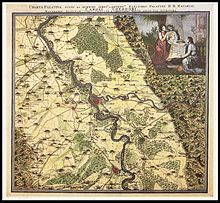Christian Mayer (physicist)
Christian Mayer (born August 20, 1719 in Mederitz , Moravia , † April 16, 1783 in Mannheim ) was a German experimental physicist , astronomer , geodesist , cartographer and meteorologist who was a Jesuit .
Life
After studying theology in Mainz , he entered the Jesuit order . He then completed further studies and initially worked as a teacher for mathematics and ancient languages in Aschaffenburg . In 1751 he was appointed professor of philosophy at the University of Heidelberg , and in 1752 he moved to the first chair for experimental physics at the same university.
During a stay in Paris to study water supply , he met the local astronomers Nicolas-Louis de Lacaille , Joseph-Jérôme de Lalande , César François Cassini de Thury and Pierre Bouguer and learned the use of astronomical and geodetic devices. In 1759 he observed the first predicted return of the comet 1P / Halley with his devices, a Venus transit on June 6, 1761 in the Schwetzingen palace gardens, and partial solar eclipses on August 16, 1765 and June 24, 1778 .
In 1763, Karl Theodor appointed Mayer to the electoral court astronomer . In 1768 he was elected a member of the Leopoldina . In 1769 Mayer was invited to Saint Petersburg to observe the passage of Venus on June 3, 1769 . In 1771 he initiated the construction of the Mannheim observatory , of which he was founding director. In 1773 Mayer was appointed an extraordinary member of the Palatinate Academy of Sciences in Mannheim . He published his geodetic survey of the Electoral Palatinate in Basis Palatina (1763) and Charta Palatina (1773).
In 1774 he ordered the eight-footed wall quadrant from the instrument maker John Bird in London , with which the culminating heights of the stars should be observed. 1775 observed Mayer a Saturn covering and in 1776 the coverage of the star Aldebaran by the Moon . In 1776 and 1777, Mayer and his colleague Johann Metzger discovered over a hundred double stars . Mayer recognized that star systems, fixed star satellites, belong together and revolve around a common center of gravity. This was one of the first and important discoveries in stellar astronomy . From 1778 he was a foreign member of the Bavarian Academy of Sciences .
The Volkssternwarte Schriesheim bears his name, some exhibits from his observatories are on display in the Technoseum in Mannheim. The moon crater C. Mayer is named after him.
Fonts (selection)
- Pantometrum Pacechianum, seu instrumentum novum pro elicienda ex una statione distantia loci inaccessi , Mannheim 1762
- Basis Palatina , Mannheim 1763
- Expositio De Transitv Veneris Ante Discvm Solis D. May 23, 1769 , St. Petersburg 1769 ( digitized version )
- Nouvelle méthode pour lever en peu de temps et à peu de frais une carte générale et exacte de toute la Russie , St. Petersburg 1770
- Charter Palatina , 1773
- Tables d'aberration et de mutation , Mannheim 1778
- Thorough defense of new observations of fixed star satellites which at Mannheim on the electoral. Observatory were discovered , Mannheim 1778
- De novis in coelo sidereo phaenomenis in miris stellarum fixarum comitibus Mannhemii , Mannheim 1779 ( digitized version )
- Observations de la Comète de 1781 . In: Acts Acad. Petropolite. , 1782
Remarks
- ↑ The date was given according to the Julian calendar applicable in Russia . According to the Gregorian calendar, it was June 3, 1769 .
literature
- Kai Budde: Economy, Science and Technology in the Age of Enlightenment . State Museum for Technology and Work, Mannheim 1993.
- Siegmund Günther : Mayer, Christian . In: Allgemeine Deutsche Biographie (ADB). Volume 21, Duncker & Humblot, Leipzig 1885, pp. 89-91.
- Adolf Kistner: The care of the natural sciences in Mannheim at the time of Karl Theodor . Self-published by the Mannheimer Altertumsverein, Mannheim 1930.
- Alexander Moutchnik : Research and teaching in the second half of the 18th century. The natural scientist and university professor Christian Mayer SJ (1719-1783) . (Algorism, Studies on the History of Mathematics and Natural Sciences; Vol. 54). Erwin Rauner Verlag, Augsburg 2006, ISBN 3-936905-16-9 ( table of contents, PDF ).
- Felix Schmeidler : Mayer, Christian. In: New German Biography (NDB). Volume 16, Duncker & Humblot, Berlin 1990, ISBN 3-428-00197-4 , p. 536 f. ( Digitized version ).
- Constantin von Wurzbach : Mayer, Christian (Jesuit) . In: Biographisches Lexikon des Kaiserthums Oesterreich . 18th part. Kaiserlich-Königliche Hof- und Staatsdruckerei, Vienna 1868, pp. 91–93 ( digitized version ).
Web links
- German biography information about Christian Mayer
- Christian Mayer's double star catalog from 1779
- Press release from Heidelberg University
- Christian Mayer and the fixed star satellites
- Literature by and about Christian Mayer in the catalog of the German National Library
| personal data | |
|---|---|
| SURNAME | Mayer, Christian |
| BRIEF DESCRIPTION | Experimental physicist, astronomer, geodesist, cartographer, meteorologist and Jesuit |
| DATE OF BIRTH | August 20, 1719 |
| PLACE OF BIRTH | Mederitz (Moravia) |
| DATE OF DEATH | April 16, 1783 |
| Place of death | Mannheim |


